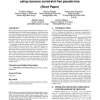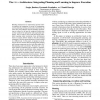137 search results - page 23 / 28 » Learning and Multiagent Reasoning for Autonomous Agents |
ENTCS
2006
13 years 7 months ago
2006
Conventional approaches to the modeling of autonomous agents and agent communication rely heavily on the ascription of mental properties like beliefs and intentions to the individ...
ATAL
2008
Springer
13 years 9 months ago
2008
Springer
The Distributed Constraint Optimization Problem (DCOP) is a fundamental formalism for multi-agent cooperation. A dedicated framework called Resource Constrained DCOP (RCDCOP) has ...
ICRA
2010
IEEE
13 years 6 months ago
2010
IEEE
— Reinforcement learning (RL) algorithms have long been promising methods for enabling an autonomous robot to improve its behavior on sequential decision-making tasks. The obviou...
ATAL
2005
Springer
14 years 1 months ago
2005
Springer
Matchmaking will be an important component of future agent and agent-like systems, such as the semantic web. Most research on matchmaking has been directed toward sophisticated ma...
AAAI
2008
13 years 9 months ago
2008
Building architectures for autonomous rational behavior requires the integration of several AI components, such as planning, learning and execution monitoring. In most cases, the ...


